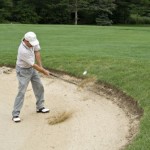Exploring the Golf Swing Mechanics (golf lesson) of the Pre-Swing
If you want to improve your golf swing, it is a good idea to first breakdown the golf swing into its component parts and explore golf swing mechanics and exactly what your body is doing when it strikes a golf ball.
One of the most important parts of the golf swing is actually the part before you hit the ball. It is in the pre-swing phase that you essentially setup the foundations for the swing. If you get this part wrong then you can virtually guarantee a bad shot, regardless of how much power you hit the ball with, or how silky smooth other aspects of your game are.
The pre-swing has three main components to it:
1/ Your Posture
How you address the ball is critical if you want to hit a good golf shot. You need to stand upright with you back straight and a slight bend in your knees. Typically, your stance would be square to the ball and about shoulder width apart. This is wide enough that you can later get power through the ball, but not so wide that you lose core stability.
Your arms should be relatively loose as any small tensions that you feel in them will be carried through to the shaft of the club, and in turn the ball.
Your weight distribution should be slightly placed forwards, with a good weight balance between your two feet.
2/ Your Body Alignment
The way that players choose to strike the ball does differ based on their particular preferences, but it does have some consistent features.
The ball is normally struck from a position of center of the feet and in alignment with the center of the body. But there are some players who prefer to have the ball positioned slightly to the right.
It is actually more important that you are consistent with this, then that you worry too much about where you choose to place the ball.
If you consistently place the ball in the same place then your body will learn and adapt how to strike from that position. But if you keep moving it around then you are essentially sabotaging yourself.
3/ The Grip on the Club
How you grip the club is another very important aspect of the golf swing, because it establishes a baseline of both stability and also direction and the power connection between club and ball.
There are a number of different grips you can use including the interlocking grip, the Vardon overlap and the baseball grip.
The best thing is to try out different ones and see which one feels the most comfortable and then stick with it.
The golf swing mechanics of the main stroke itself depend upon the demands of the shot.
A typical golf swing is comprised of a release of power through the left arm, which then in turn frees up the club, and then there is a roll of forearm and left arm, which twists the head of the club onto the ball and results in the impact.
The shoulder socket is key during the swing because it acts like a pendulum pivot around which the arms are swung.
In a very real sense, it acts like a fulcrum for the power that is generated up through the body as denoted by the final twist in the legs.
The aim of the swing should be to synchronize the release of the power and the twist at the moment of impact with the ball.
Start to break down your own action into its component parts to better understand it, and above all keep practicing!
There are more details at golf swing tips part 3



1 Comment
I can see from this article that my body alignment and posture is not near what it should be. My weight has been on the rear foot. Good article.